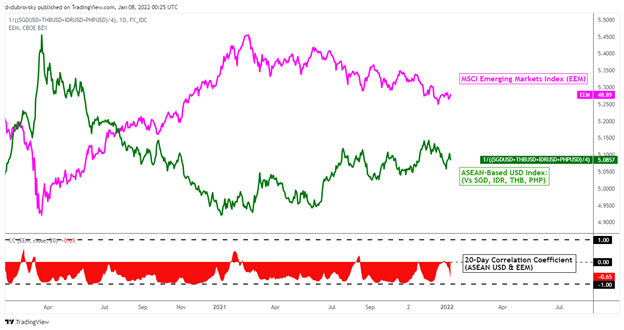US Dollar, Singapore Dollar, Thai Baht, Indonesian Rupiah, Philippine Peso, ASEAN, Fundamental Analysis – Talking Points
- US Dollar advances against ASEAN currencies to start of 2022
- A more hawkish Fed risks souring Emerging Market sentiment
- All eyes on US inflation data and Chinese December trade figures
US Dollar ASEAN Weekly Recap
The US Dollar outperformed against some of its ASEAN counterparts to start off 2022. Gains were seen against the Singapore Dollar, Thai Baht, Indonesian Rupiah and Philippine Peso. A deterioration in ASEAN market sentiment likely played a key factor – see chart below. A notable standout was Indonesia, where gains in key commodity prices, such as palm oil and coal, may have offset a generally pessimistic tone around the Emerging Asia-Pacific region.
MSCI ASEAN Indices 1-Hour Chart
Chart Created Using TradingView
External Event Risk – Capital Outflows, Fed Rate Hike Bets, US CPI
The US Dollar may be setting itself up for another solid weak against ASEAN currencies, which may end up being the trend in the near term. Last week, the latest FOMC meeting minutes revealed a notable hawkish pivot from policymakers. Looking at Fed Funds Futures, the market is pricing in 3 rate hikes this year. Moreover, the central bank may even initiate quantitative tightening in 2022.
This poses a risk to Emerging Markets as it threatens capital outflows from the region. When the Fed raises rates, returns on safer Treasury yields tend to follow, especially on the front end of the curve. As a result, investing in the stock market becomes more costly as the ‘risk-free’ rate rises. As such, traders may pull away or unwind their riskiest exposure, which Emerging Markets tend to fall under.
Then there is the impact of what a rising US Dollar could mean for servicing debt that Emerging Markets owe in the global reserve currency. A combination of rising interest rates and a stronger Greenback work to make servicing those repayments more difficult. It should be noted though that a lot of ASEAN countries have accumulated ample foreign exchange reserves, which could help offset local currency depreciation.
With that in mind, Emerging Markets will be closely monitoring the upcoming US CPI report. On Wednesday, headline inflation is expected to rise 7.0% y/y in December, up from 6.8% in November. That would be the fastest pace in 40 years. If this fuels more hawkish Fed monetary policy bets, then USD/SGD, USD/THB, USD/IDR and USD/PHP may rise in the week ahead on average.
Check out the DailyFX Economic Calendar for ASEAN and global data updates!
ASEAN, South Asia Economic Data – Chinese and Philippine Trade Data
This week’s ASEAN economic docket is relatively light outside of Philippine trade figures, Indonesian and Thailand consumer confidence surveys. Chinese trade data is also slated to cross the wires on Friday. For many ASEAN nations, China is a key trading partner. This year, slowing demand for Chinese exports could hurt the economy, pushing the US Dollar higher against the Yuan. Exports are anticipated to rise 20% y/y in December, down from 22% prior.
On January 7th, the 20-day rolling correlation coefficient between my ASEAN-based US Dollar index and the MSCI Emerging Markets Index changed to -0.65 from -0.04 one week ago. Values closer to –1 indicate an increasingly inverse relationship, though it is important to recognize that correlation does not imply causation.
ASEAN-Based USD Index Versus EEM Index – Daily Chart

Chart Created Using TradingView
*ASEAN-Based US Dollar Index averages USD/SGD, USD/IDR, USD/THB and USD/PHP
— Written by Daniel Dubrovsky, Strategist for DailyFX.com
To contact Daniel, use the comments section below or @ddubrovskyFX on Twitter


Be the first to comment